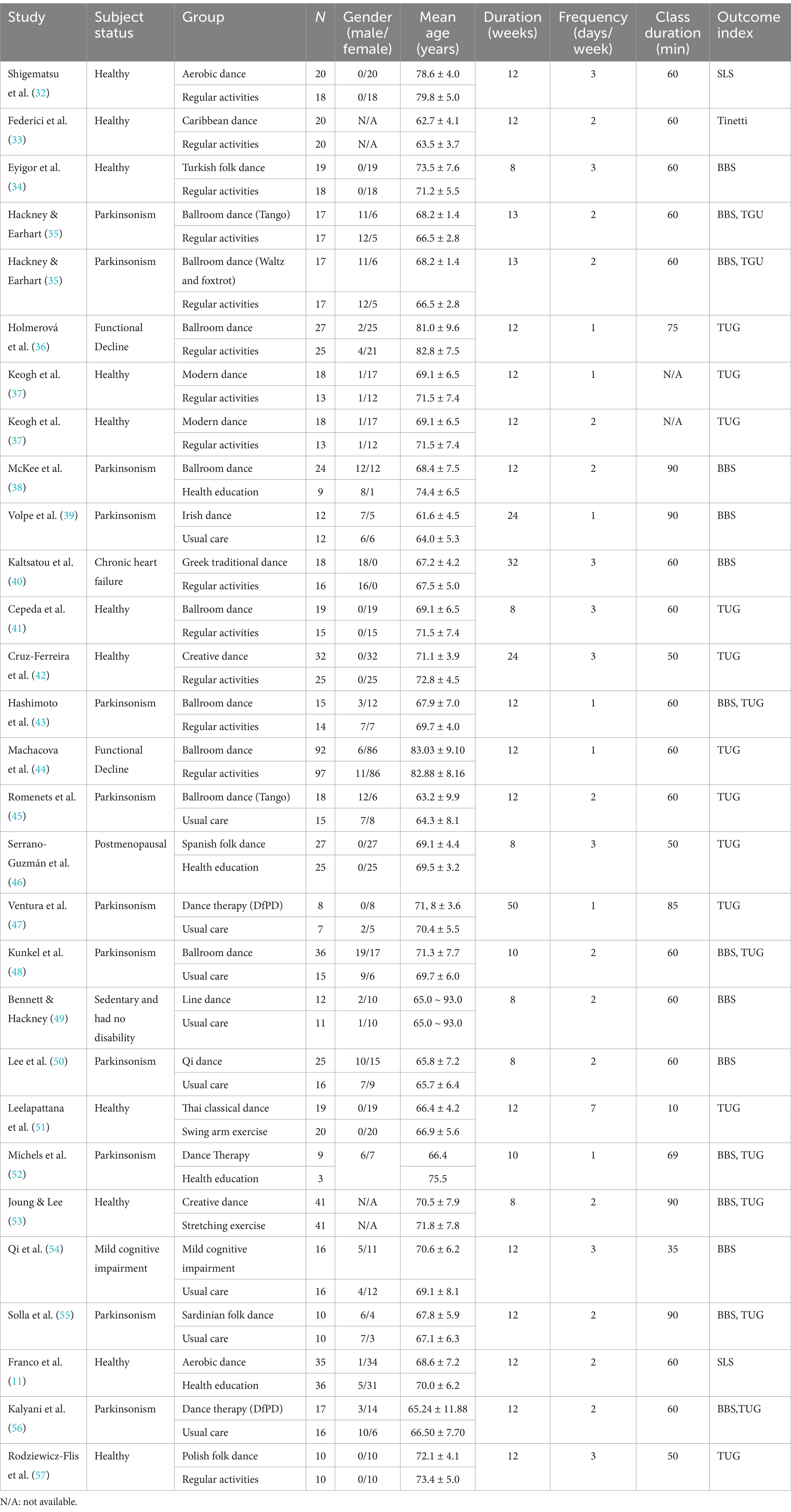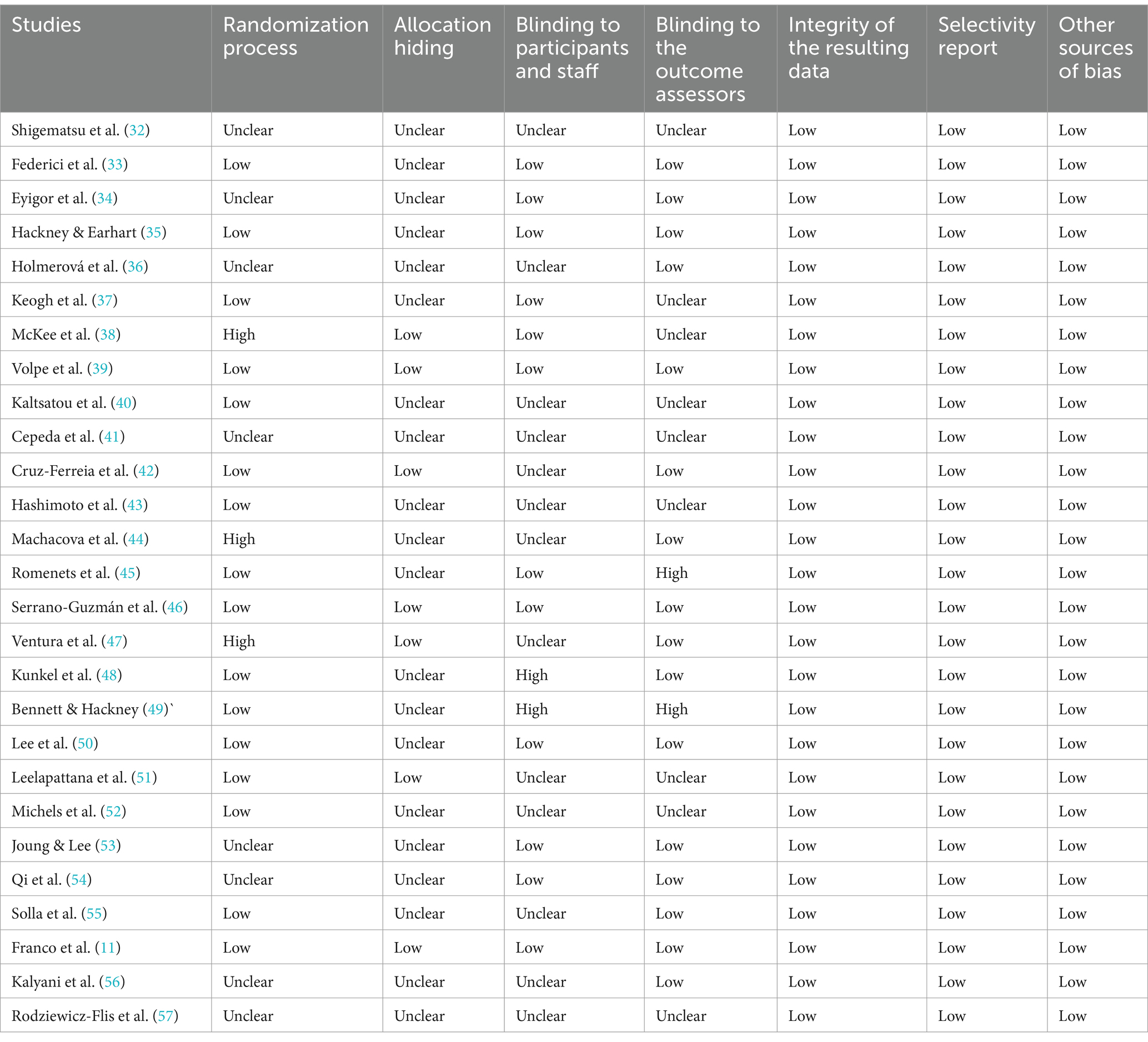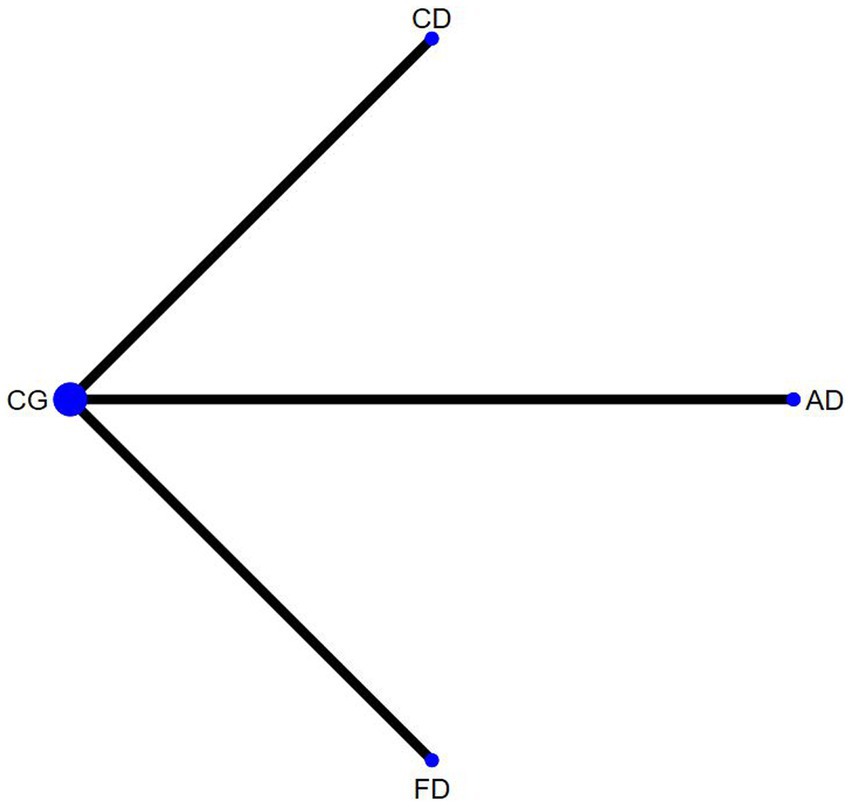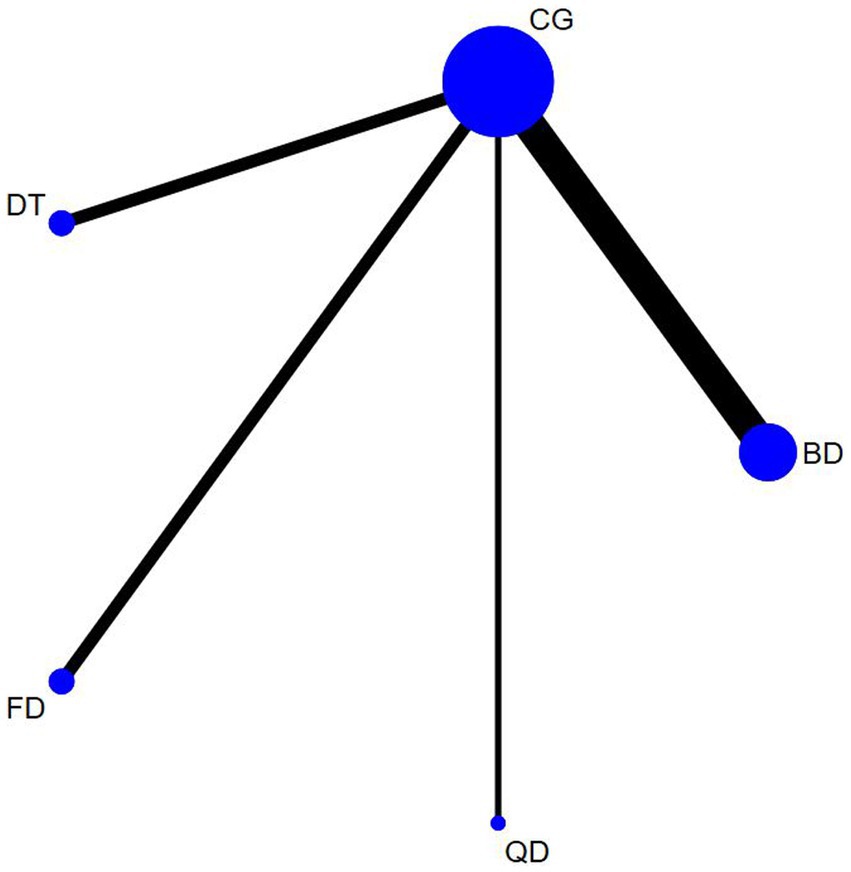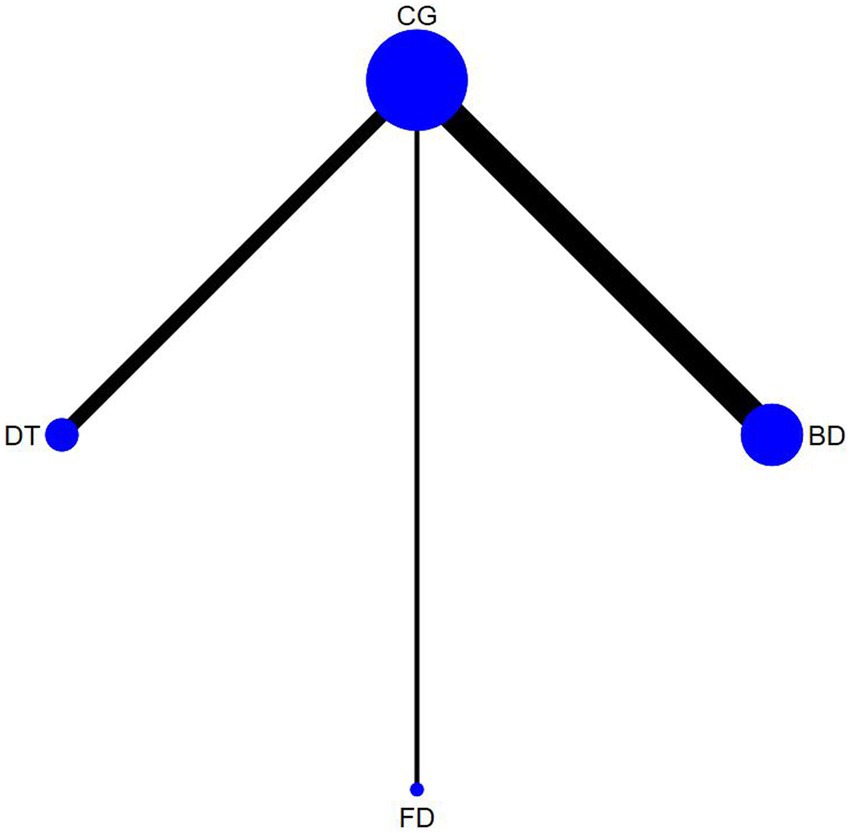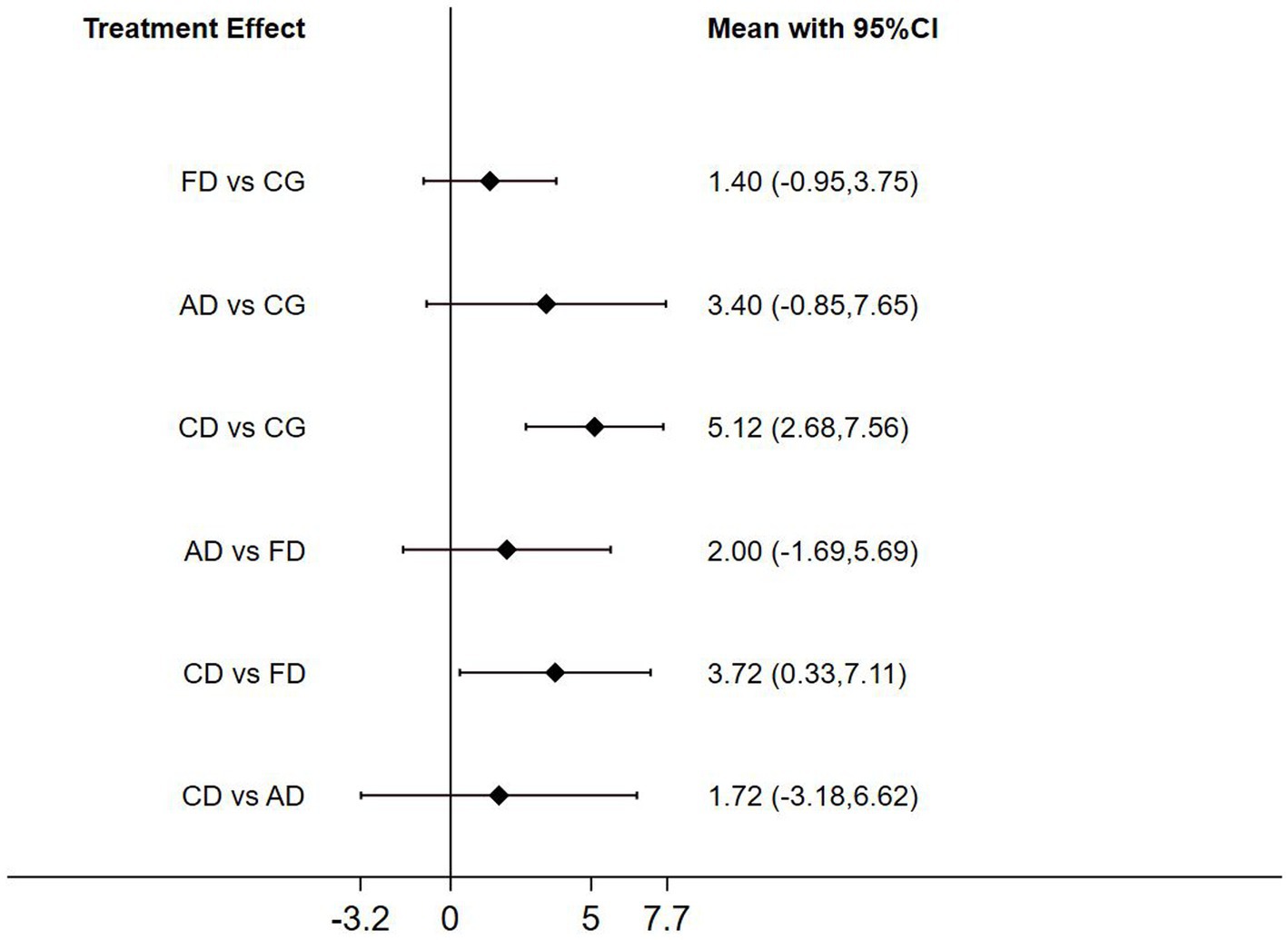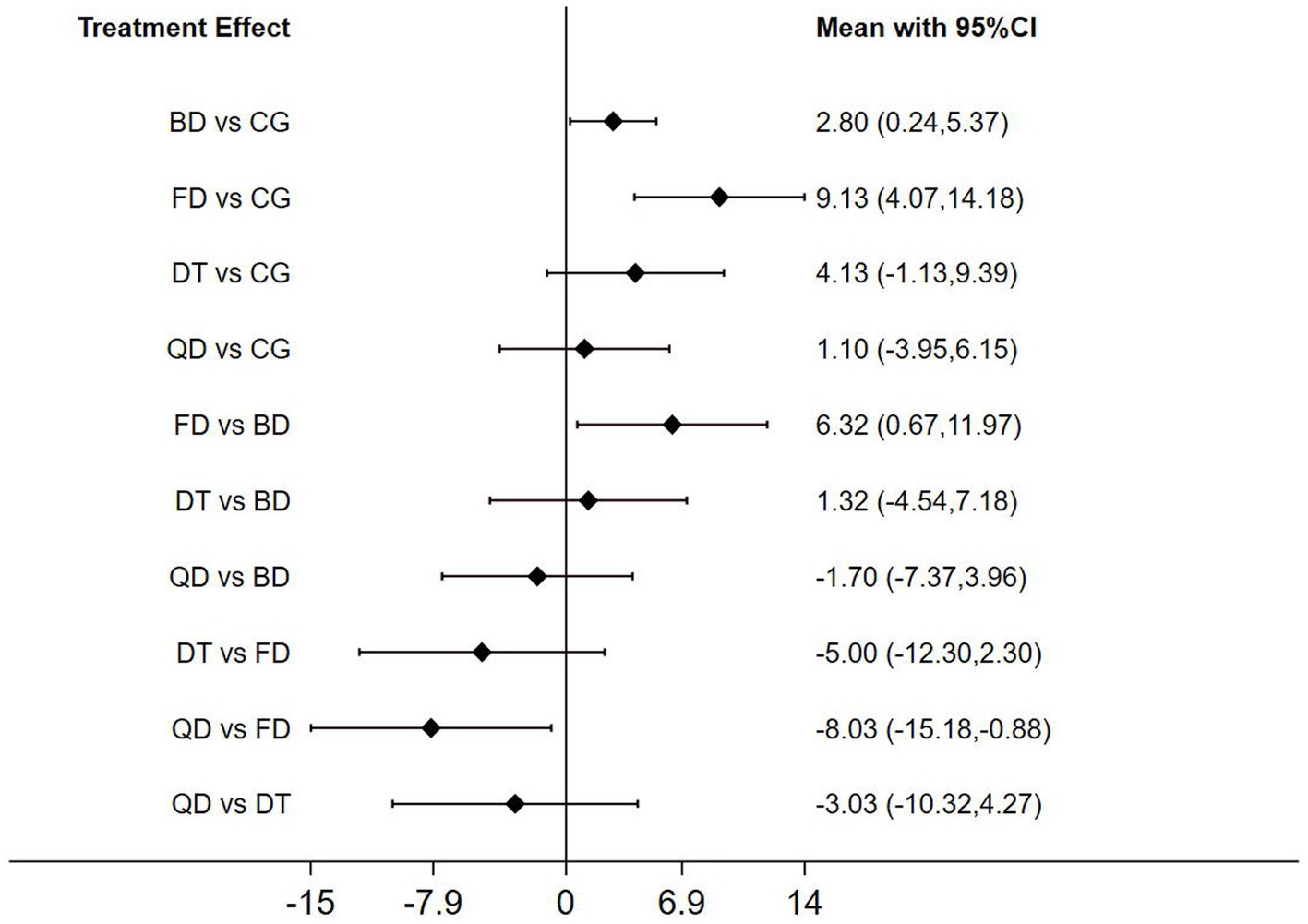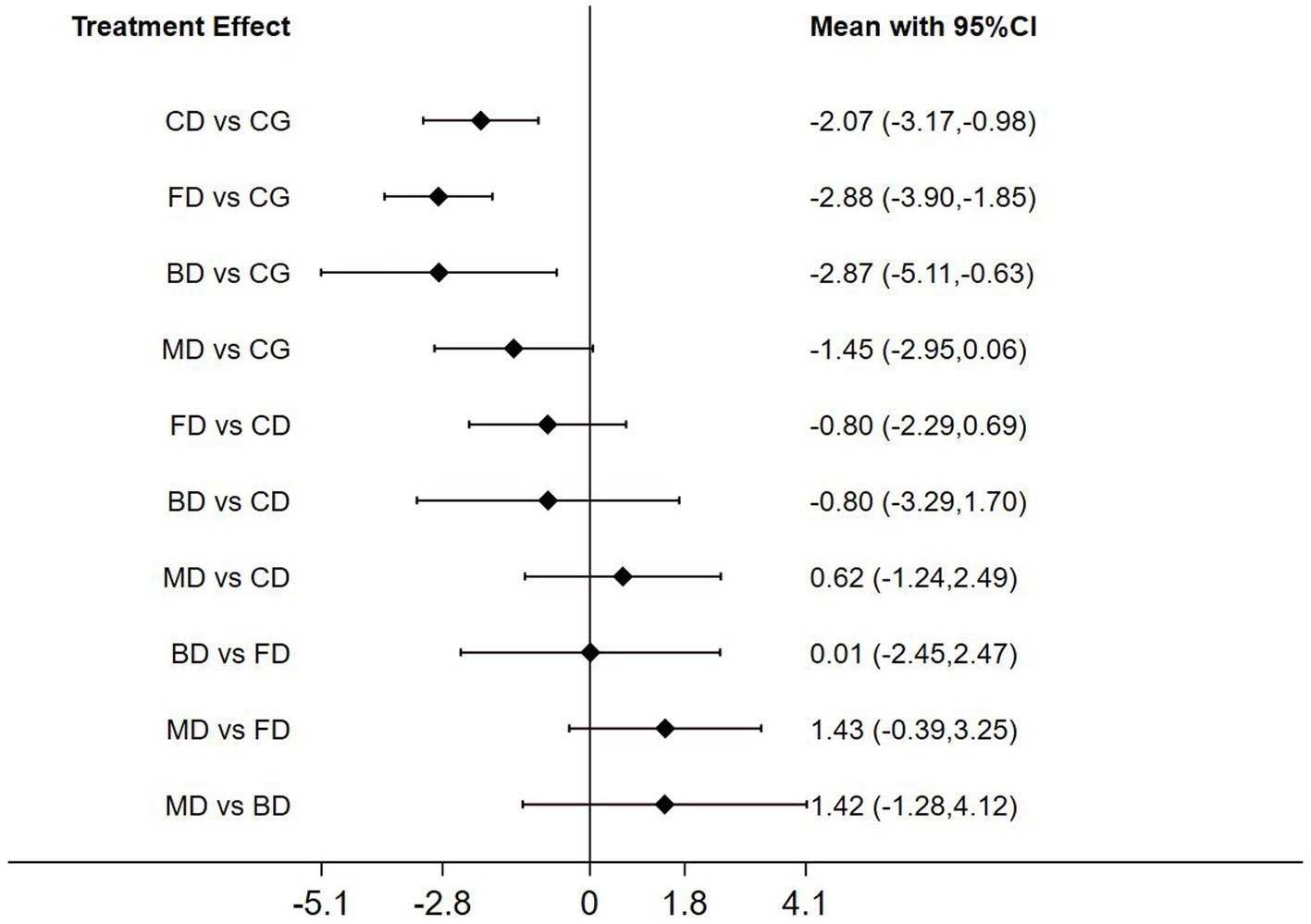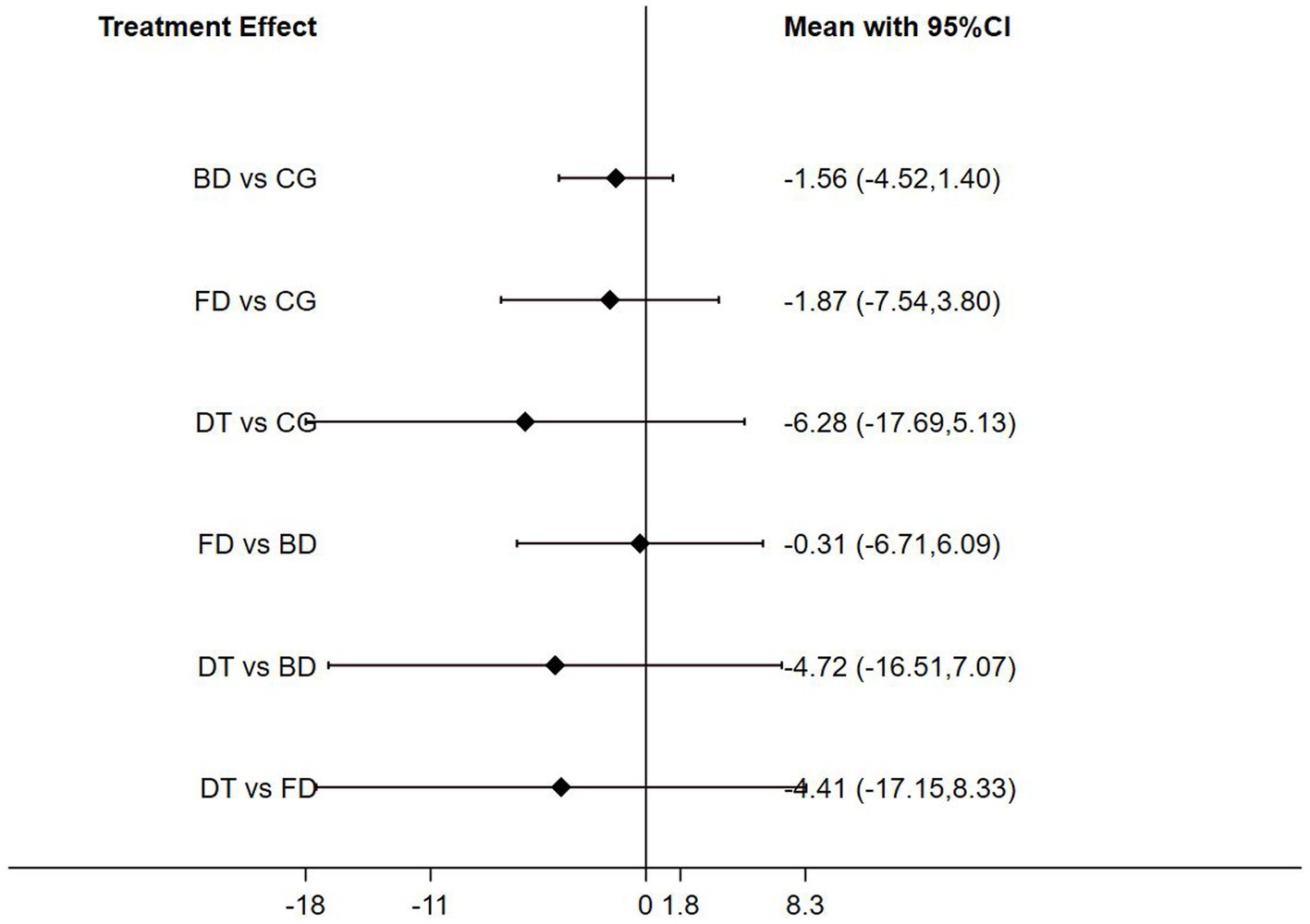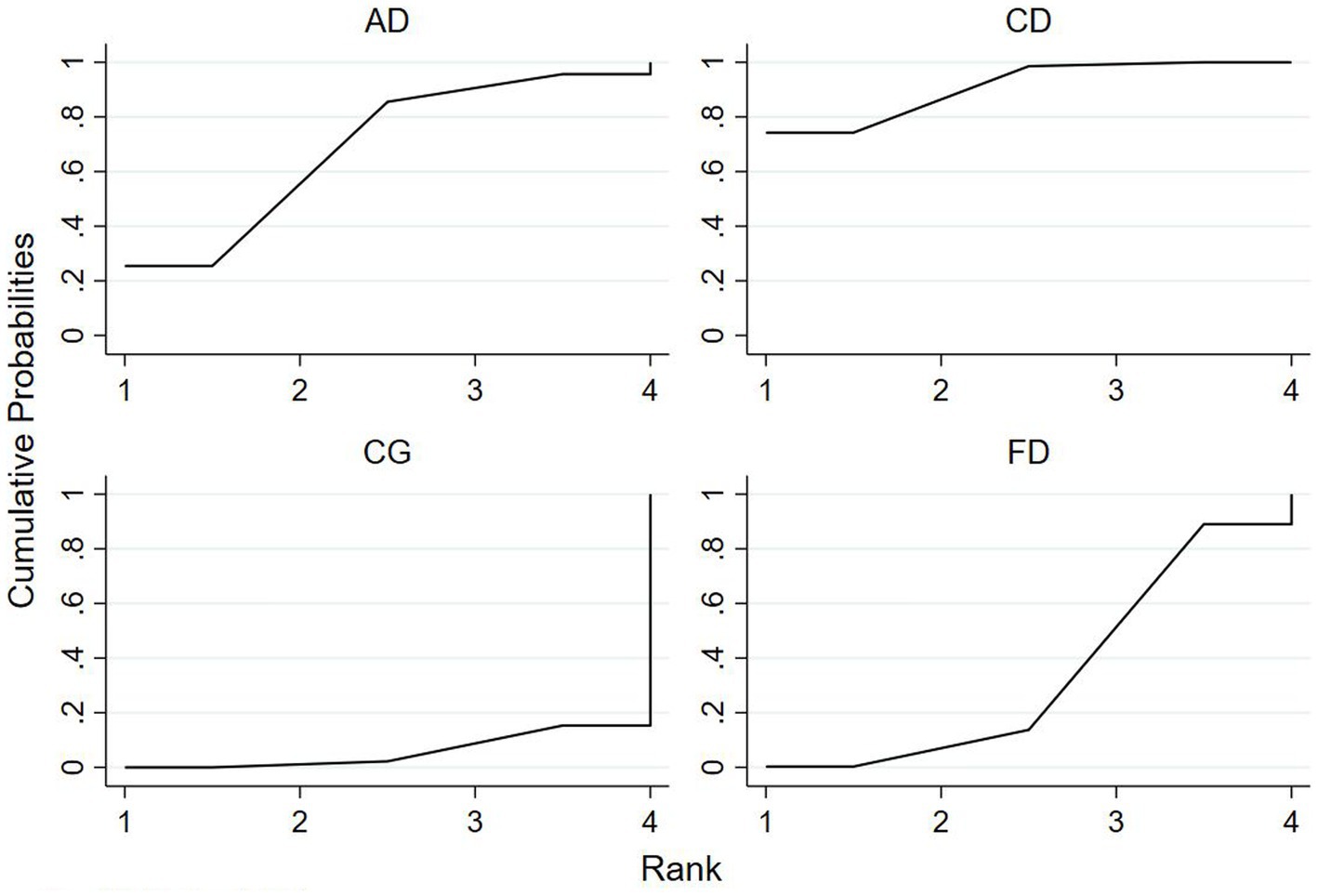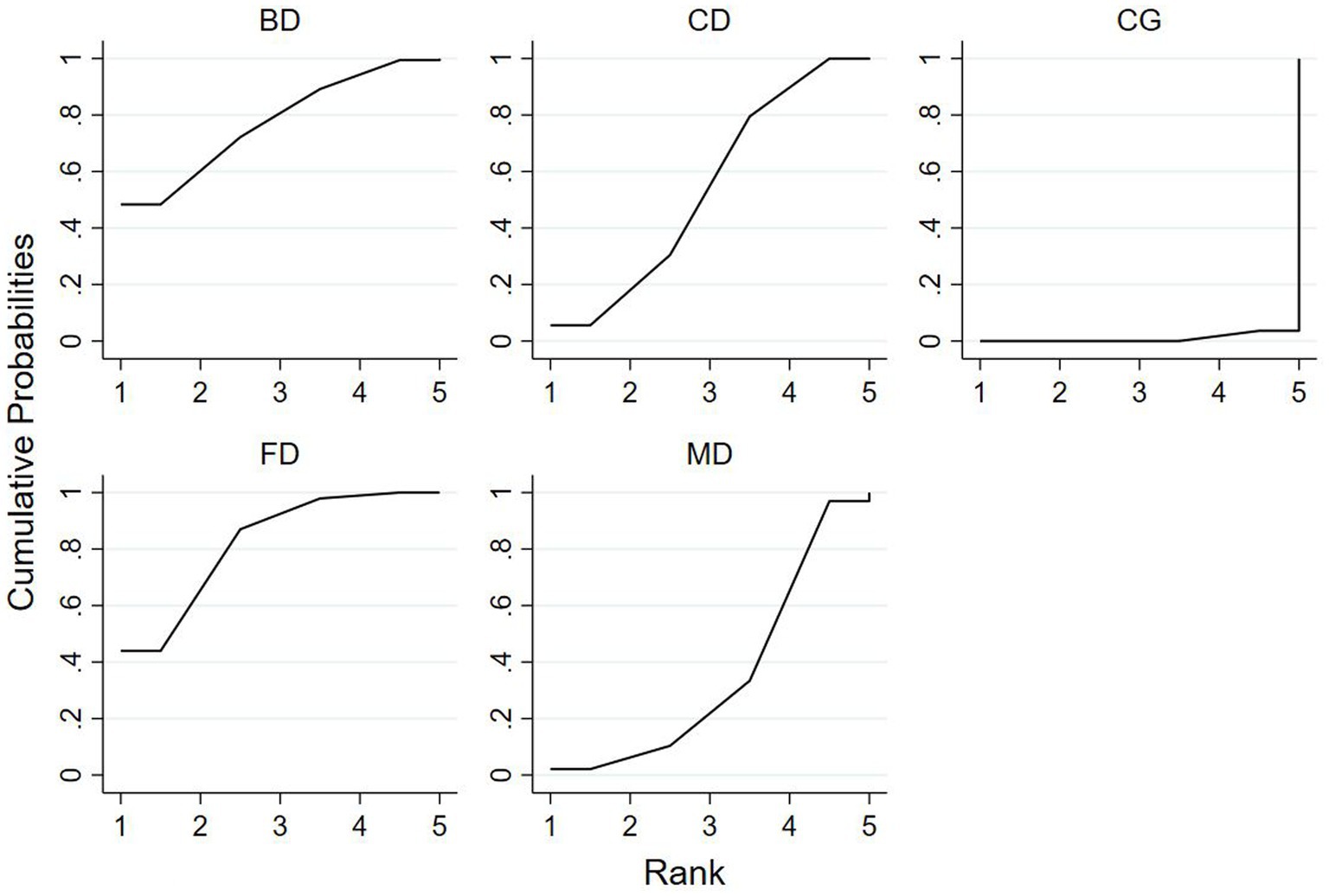- 1Sports Department, Harbin Engineering University, Harbin, China
- 2School of Sports Medicine and Rehabilitation, Beijing Sport University, Beijing, China
Objective: The efficacy of dance in reducing fall risks among older adults highlights its potential for geriatric health, but the optimal dance style remains uncertain. The present study endeavors to systematically analyze the effects of various dance forms on reducing the risk of falls among older adult, with the aim of providing evidence-based insights into the most efficacious dance styles for this population.
Design: The network meta-analysis of the existing literature was conducted to synthesize the available evidence regarding the effectiveness of various dance interventions in reducing the risk of falls among older adults.
Methods: We searched seven databases for randomized controlled trials on dance interventions for fall prevention in older adults and used Stata 17.0 for network meta-analysis.
Results: Twenty-seven studies (n = 1,219 older adults) were included. Creative Dance (CD) significantly improved the Berg Balance Scale score in healthy older adults (p < 0.05) and ranked best. Folk Dance (FD), CD, and Ballroom Dance (BD) all significantly improved Timed Up and Go time compared to controls, with FD ranking best overall. In Parkinson’s disease patients, both BD and FD significantly improved the Berg Balance Score, with FD again ranking best.
Conclusion: Creative dance, Folk dance, and Ballroom dance effectively reduce the risk of falls in older adults. Creative dance enhanced the Berg Balance Score the most among healthy older adults, while Folk dance improved the Timed Up and Go test performance the best. Similarly, among patients with Parkinson’s disease, Folk dance exhibits the best effect in improving Berg Balance Scale scores.
Clinical trial registration: The protocol of this study was registered with the International Prospective Register of Systematic Review, PROSPERO, under the identification number CRD42022323426, and can be integrally assessed online (https://www.crd.york.ac.uk/prospero/display_record.php?ID=CRD42022323426).
Introduction
Falls are inadvertent events involving the descent of an individual to the ground or any other lower surface (1). These incidents pose a significant health risk, with over half of falls leading to soft tissue injuries, fractures, and other severe injuries, or even fatalities (2). Furthermore, even in the absence of physical harm, falls can inflict long-lasting psychological sequelae, including depression and an increased fear of falling, which can subsequently limit daily and social activities, deteriorate physical fitness and function, and exacerbate the risk of future falls (3, 4). Alarmingly, approximately 28 to 35% of individuals aged 65 and older experience a fall annually, with this proportion escalating to 32 to 42% among those aged 70 and above (5). These statistics highlight the pressing need for effective interventions to mitigate the burden of falls on older adults.
Risk factors for falls can be categorized into intrinsic and extrinsic categories. Intrinsic factors encompass aging, chronic illnesses, reduced muscle strength, gait and balance disorders, as well as cognitive impairments. Conversely, extrinsic factors comprise medication use, unfavorable environments, and hazardous activities (6). Notably, among these factors, diminished balance ability stands out as a primary cause of falls among older adults (7). Specifically, the balance ability of individuals aged 60 and above declines by approximately 16% every decade, thereby heightening their vulnerability to falls (8). Furthermore, impaired balance and gait function serve as potent predictors of fall risk in this population, underscoring their significance in assessing an individual’s predisposition to falls (9). Consequently, by assessing gait and balance abilities in older adults, it is feasible to anticipate fall risk and subsequently implement targeted preventive measures (10).
Dance, a harmonious blend of rhythmic motions, embodies intricate emotional, physical, cognitive, and social dimensions (11). Its diverse styles, intricate steps, and accompanying melodies hold a particular appeal for older adults, motivating them to engage in extended practice sessions (12, 13). This practice has been shown to exert a salutary influence on various risk factors associated with falls, including enhancements in balance, gait dynamics, strength, and flexibility (14–16). This benefit is particularly pronounced among individuals with chronic health conditions (17–21).
While several meta-analyses have unequivocally affirmed dance’s efficacy in mitigating the risk of falls among the older adult (22, 23), a notable gap remains in the literature regarding a direct comparison of the improvement effects elicited by different dance forms. Thus, there is a pressing need to explore and compare the specific contributions of various dance styles to the overall wellbeing and fall prevention of older adults.
Network Meta-analysis, an evolution from the conventional Meta-analysis framework, offers a robust methodology for identifying the “optimal” intervention options by comprehensively comparing their direct and indirect effects (24). The present study employs Network Meta-analysis to evaluate the efficacy of various dance interventions in mitigating falls among older adults. Our objective is to provide evidence-based recommendations for effective dance-based interventions that can contribute to reducing fall risk in this population. By doing so, we aim to contribute to the development of tailored and targeted fall prevention strategies tailored specifically for older individuals.
Methods
Protocol and registration
This research followed the Preferred Reporting Items for Systematic Reviews and Meta-analyses (PRISMA) statement checklist (25, 26) and was registered in the International Prospective Register of Systematic Reviews (PROSPERO; CRD42022323426).
Search strategy
The search was carried out in 8 November 2024 using the electronic databases CNKI, WanFang Data, PubMed, EBSCO, Web of Science and Cochrane Library. The search comprised the following terms and MeSH terms: dancing, fall, aged, older adult, randomized controlled trial, randomized, and placebo. No restrictions on language or publication type were applied. The electronic search was complemented by hand-searching the references of included papers and previous reviews.
Eligibility criteria
This study included reports of published, peer-reviewed RCTS that investigated the effects of dance on balance and fall outcomes in older adults.
Types of participants: This study included only randomized controlled trials (RCTs) involving older adults aged 60 years and above. The health status of the participants was clearly reported in all included studies. The experimental arm of these trials featured a single dance intervention as the sole additional treatment compared to the control group. We excluded studies on specific conditions (e.g., hospitalized individuals), where the effects of the interventions cannot be generalized to most community-dwelling older adults.
Types of outcomes: (1) Berg Balance Scale (BBS): A validated tool assessing balance function and predictive of fall risk, with a total score of 56. Higher scores signify superior balance capabilities (27); (2) Timed Up and Go Test (TUG): Evaluates functional walking ability and fall risk by measuring the time taken for an individual to rise from a seated position, walk a distance of 3 meters, turn around, walk back, and sit down again. Shorter completion times indicate greater mobility (28). (3) Tinetti Scale (Tinetti): Comprehensively assesses mobility, balance, and gait, with a focus on predicting falls. It comprises both a balance test and a gait test, where higher scores reflect better balance and walking abilities (29). (4) Single-Leg Standing Test (SLS): A test of balance where participants, with hands either hanging naturally by their sides or placed flat to the left and right, stand on one foot with their eyes closed. The duration of maintaining this position is recorded, with shorter durations indicative of poorer balance (30).
Exclusion Criteria: (1) Academic dissertation, conference thesis and thesis abstract; (2) Literature where the mean and standard deviation of outcome indicators cannot be calculated; (3) Non-compliance with outcome indicators; (4) Full text is not available and failed to contact the author.
Data extraction
The data extraction process for the included studies was conducted independently by two researchers, with a focus on the following variables: (1) Study characteristics, encompassing the author, year of publication, and study design, as well as the sample demographics including size, gender distribution, and age range; (2) A detailed description of the intervention program, specifically the type of dance intervention, its frequency, and duration, along with the characteristics of the control group; (3) Pertinent outcome data, including the mean values and standard deviations of the primary outcome indicators. Any discrepancies encountered during the extraction process were resolved through consensus or, if necessary, by consulting a third reviewer.
Risk of bias within studies
The risk of bias in all included studies was independently evaluated by two reviewers utilizing the Cochrane Collaboration’s risk of bias tool. Any discrepancies encountered during this process were resolved through thorough discussion and negotiation. In cases where consensus could not be reached, a third investigator was consulted for assistance in adjudicating the risk assessment (25).
The literature evaluation encompassed five key aspects: randomization method, allocation concealment, blinding of participants and/or personnel, blinding of outcome assessment, and selection of reported results. Studies that explicitly described these characteristics in their published documents were deemed to have met the criteria and were subsequently classified as either “low risk” or “high risk” of bias. Conversely, studies that failed to provide sufficient information on these aspects were classified as having an “unclear risk” of bias.
Statistical analysis
Network meta-analysis was performed using a frequentist framework, implemented in the Stata 17.0 software package. For continuous outcomes, the mean difference (MD) with 95% confidence intervals (CIs) was employed as the measure of effect. Studies of older adults with different health status were analyzed separately.
To visually depict the comparative relationships among dancing interventions and control groups, a network diagram was constructed, wherein the thickness of the connecting lines represented the number of comparative studies between any two interventions. The surface under the cumulative ranking curve (SUCRA) served as the ranking index, with 100% indicating the most efficacious intervention and 0% suggesting the least effective or ineffectual intervention (31).
Furthermore, funnel plots were generated to scrutinize potential small-study effects across the included studies, ensuring a rigorous assessment of the data and enhancing the credibility of our findings.
Results
Search results
The initial search process yielded a comprehensive pool of 701 articles, comprising 42 articles retrieved from CNKI, 23 from WanFang Data, 107 sourced from PubMed, 153 from the Cochrane Library, 224 from Web of Science, 26 from EBSCO, and an additional 4 articles discovered through alternative search pathways (specifically, studies incorporated in relevant literature reviews). Following a rigorous and meticulous layer-by-layer screening procedure, a final selection of 27 articles (11, 32–57) was deemed to fulfill the stringent inclusion criteria established for this review (Figure 1).
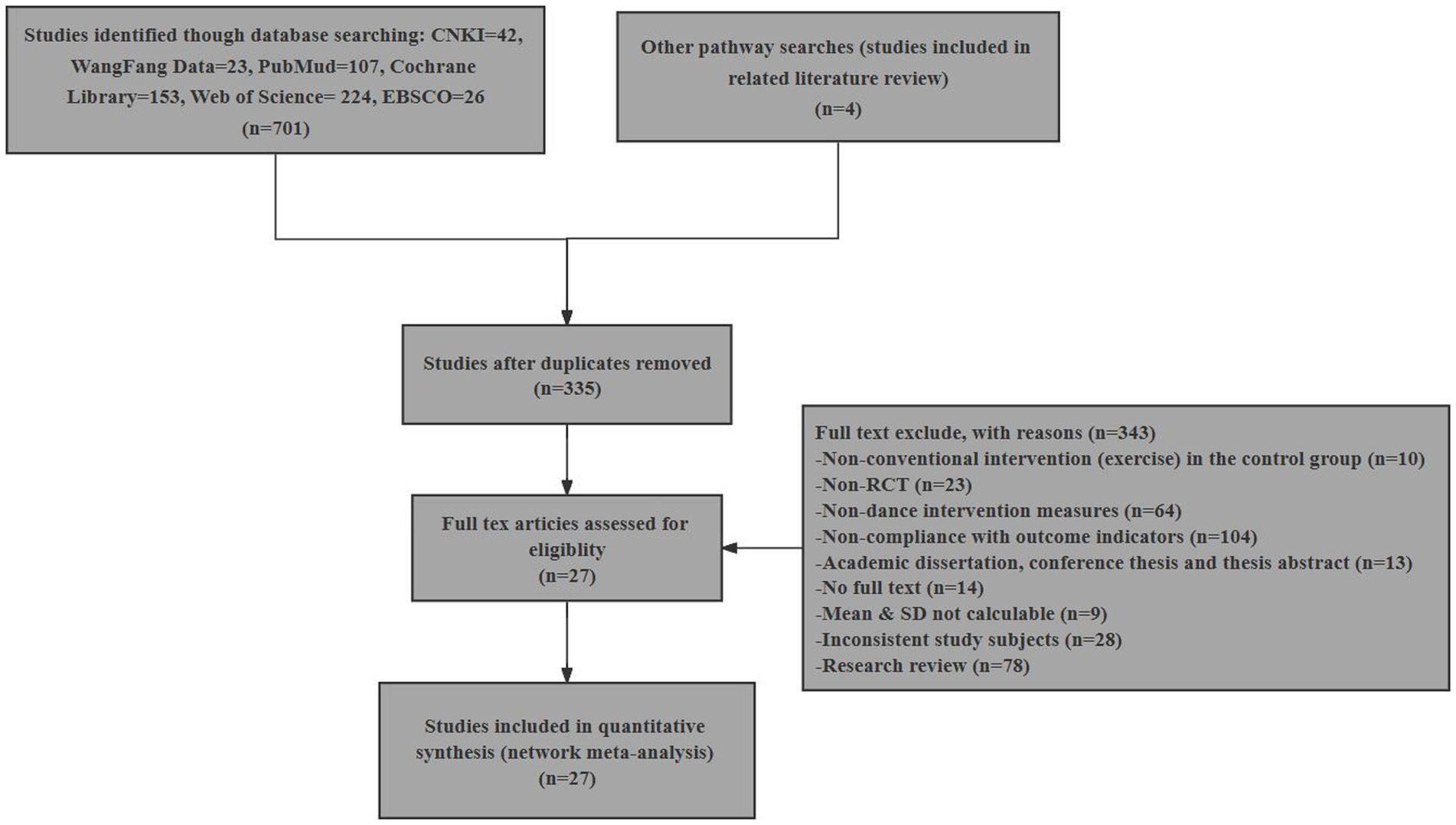
Figure 1. Study selection flowchart according to the Preferred Reporting Items for Systematic Reviews and Meta-Analyses (PRISMA) statements.
Characteristics of the included studies
The characteristics of the included studies are presented in Table 1. Among the studies included in this review. The study population encompassed 1,219 participants. Twelve of which the studies included healthy older adults (such as older adults who live independently in the community; n = 548). Eleven studies included patients with Parkinson’s disease (n = 341). One study included people with Mild Cognitive Impairment (n = 32). One study included people with chronic cardiac failure (n = 57). Two studies included long-term nursing home residents, which was classified as function decline (n = 241).
The types of dance performed in the studies were ballroom dancing (i.e., Tango, Waltz and Fox trot), aerobic dance (i.e., Line dance and Senior Dance), Creative dance, Folk dance (i.e., Caribbean Dance, Turkish Folk Dance, Spanish folk dance, Polish folk dance, Irish dancing, Sardinian folk dance, Classical dance and Traditional Greek dance), and Dance therapy.
The intervention duration spanned from 8 to 50 weeks, with individual sessions lasting between 10 and 100 min. The frequency of interventions varied, ranging from once to seven times per week (Table 1).
Assessment of methodological quality
The risk-of-bias assessment for the 16 studies that explicitly reported randomized methods revealed that seven of these studies also documented allocation concealment measures, while 12 studies reported blinding protocols for participants, personnel involved in the study, and outcome assessors (Figure 2; Table 2).
Network meta-analysis
One study on chronic heart failure populations (40), one study on mild cognitive impairment (54), and two studies on nursing home residents (36, 44) were excluded from the network meta-analysis. The reasons for this exclusion were the heterogeneous health status of the study subjects and the fact that the premise of network meta-analysis necessitates comparisons among three or more interventions.
The outcome measures encompassed 12 studies (13 comparisons) (34, 35, 38, 39, 43, 48–50, 52, 53, 55, 56) that assessed BBS scores. In a healthy population, three studies (34, 49, 53) with three interventions were included: Creative dance (CD), Aerobic dance (AD) and Folk dance (FD; Figure 3). In patients with Parkinson’s disease, there were nine studies (10 comparisons) (35, 38, 39, 43, 48, 50, 52, 55, 57) with a total of four interventions: Dance Therapy (DT), FD, Qi dance (QD) and Ballroom dance (BD), of which BD had the thickest line in the visualization with the control group, indicating that it was the most frequently studied intervention in this context (Figure 4).
The outcome measures encompassed 16 studies (18 comparisons) (35, 37, 38, 41–43, 45–48, 50, 52, 53, 55–57) that assessed TUG scores. In a healthy population, seven studies (8 comparisons) (37, 41, 42, 46, 50, 53, 57) with four interventions were included: FD, Modern dance (MD), BD, and CD. Of these FD had the thickest line in the visualization with the control group, indicating that it was the most frequently studied intervention in this context (Figure 5). In patients with Parkinson’s disease, there were nine studies (10 comparisons) (35, 38, 43, 45, 47, 48, 52, 55, 56) with a total of three interventions: DT, FD, and BD. Similarly, Ballroom dance (BD) had the thickest line in the visualization with the control group, indicating that it was the most frequently studied intervention in this context (Figure 6).
Given that the SLS time (11, 32, 46) and Tinetti score (33) assessments encompassed only a single intervention, the application of Network Meta-analysis was deemed inappropriate and, therefore, not performed.
Network meta-analysis of berg balance scale
The Network Meta-analysis (NMA) of Berg balance scale (BBS) scores revealed that Creative dance (CD) significantly outperformed the control group (CG) in health older adults (p < 0.05). In pairwise analyses comparing the three dance interventions, notable differences in intervention effects emerged between Folk dance and Creative dance (CD vs. FD, p < 0.05; Figure 7).
The NMA of BBS scores revealed that Ballroom dance (BD) and Folk dance (FD) significantly outperformed the control group (CG) in patients with Parkinson’s disease (p < 0.05). In pairwise analyses comparing the three dance interventions, notable differences in intervention effects emerged between Folk dance and Ballroom dance (FD vs. BD, p < 0.05), notable differences in intervention effects emerged between Qi dance and Folk dance (QD vs. FD, p < 0.05; Figure 8).
Network meta-analysis of timed up and go test
The Network Meta-analysis (NMA) of Timed Up Go (TUG) time revealed that Creative dance (CD; p < 0.01), Folk dance (FD; p < 0.01) and Ballroom dance (BD; p < 0.05) significantly outperformed the control group (CG) in health older adults (p < 0.01). In pairwise analyses comparing the three dance interventions, there was no significant difference in the intervention effect of each intervention (Figure 9).
The NMA results of TUG time showed that there were no significant differences between the interventions and the control group or between interventions in patients with Parkinson’s disease (p > 0.05; Figure 10).
Ranking of mesh meta-analysis results for different interventions
The relative rankings of the intervention measures with passive control as the reference. For the Berg Balance Scale (BBS) scores, Creative dance (90.9%) ranked best followed by Aerobic dance (68.9%) and Folk dance (34.3%) in health older adults (Figure 11). Combining the results with the forest plot, it is evident that the interventions of Creative dance significantly outperform Folk dance. Folk dance ranked best (97.1%) followed by Dance therapy (61.9%), Ballroom dance (51.4%) and Qi dance (29.0%) in patients with Parkinson’s disease. Combining the results with the forest plot, it is evident that the interventions of Folk dance significantly outperform Ballroom dance and Qi dance (Figure 12).
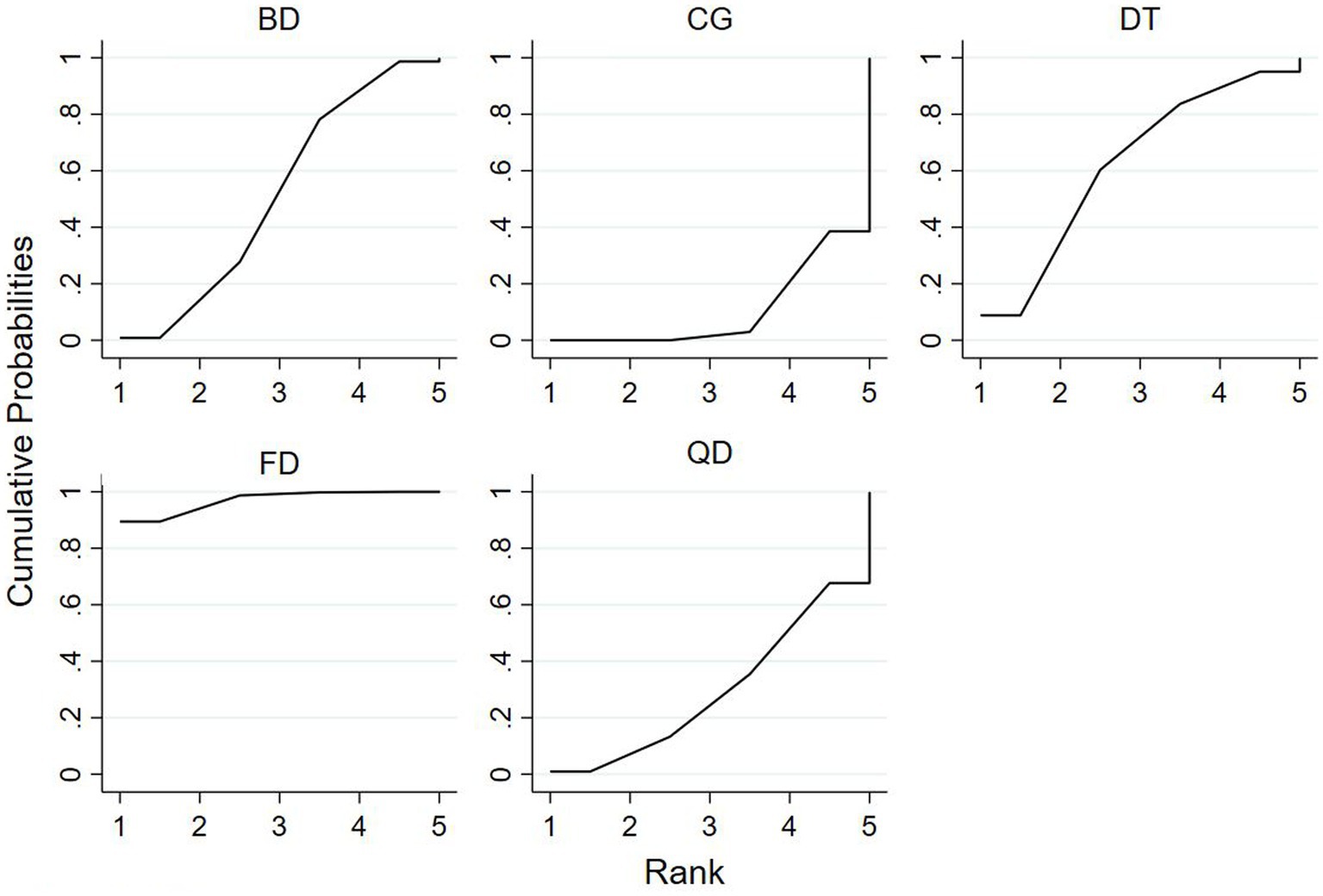
Figure 12. For patients with parkinson’s disease, the surface under the cumulative ranking curve (SUCRA) in BBS.
For TUG time, Folk dance (82.4%) ranked best followed by Ballroom dance (76.8%), Creative dance (54.1%) and Modern dance (35.8%) in health older adults (Figure 13). Dance therapy (70.0%) ranked best followed by Folk dance (59.9%) and Ballroom dance (56.6%) in patients with Parkinson’s disease (Figure 14).
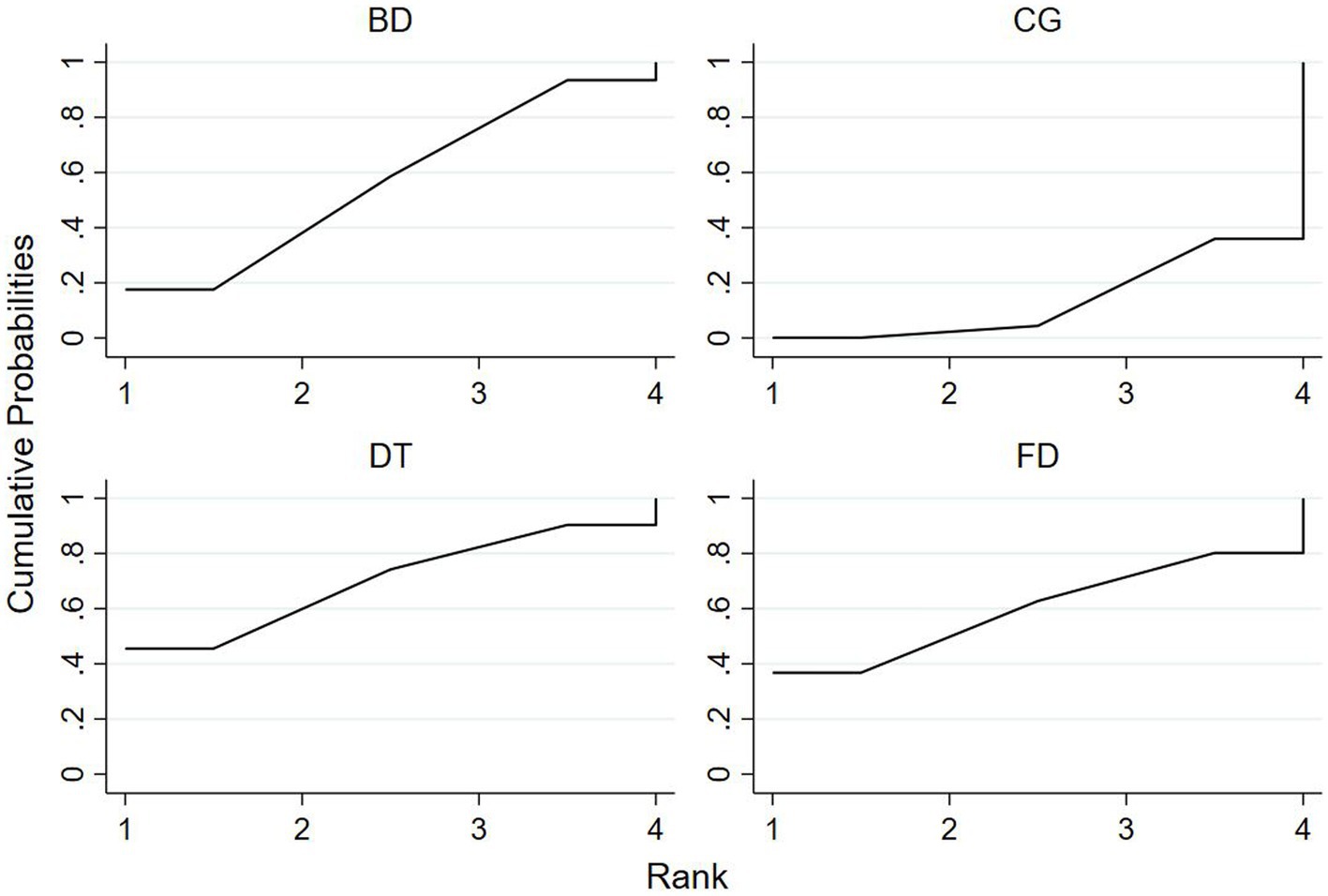
Figure 14. For patients with parkinson’s disease, the surface under the cumulative ranking curve (SUCRA) in TUG.
Publication bias analysis
Funnel plots were employed to assess publication bias within the included study outcome measures, specifically BBS scores and TUG time. Each study was positioned with the midline serving as the symmetry axis, with the majority of studies clustering around this axis and exhibiting rough symmetry on both sides, suggestive of minimal publication bias. However, a few isolated points were observed to be dispersed beyond the symmetry axis, potentially indicating the presence of small sample size effects (Figure 15).
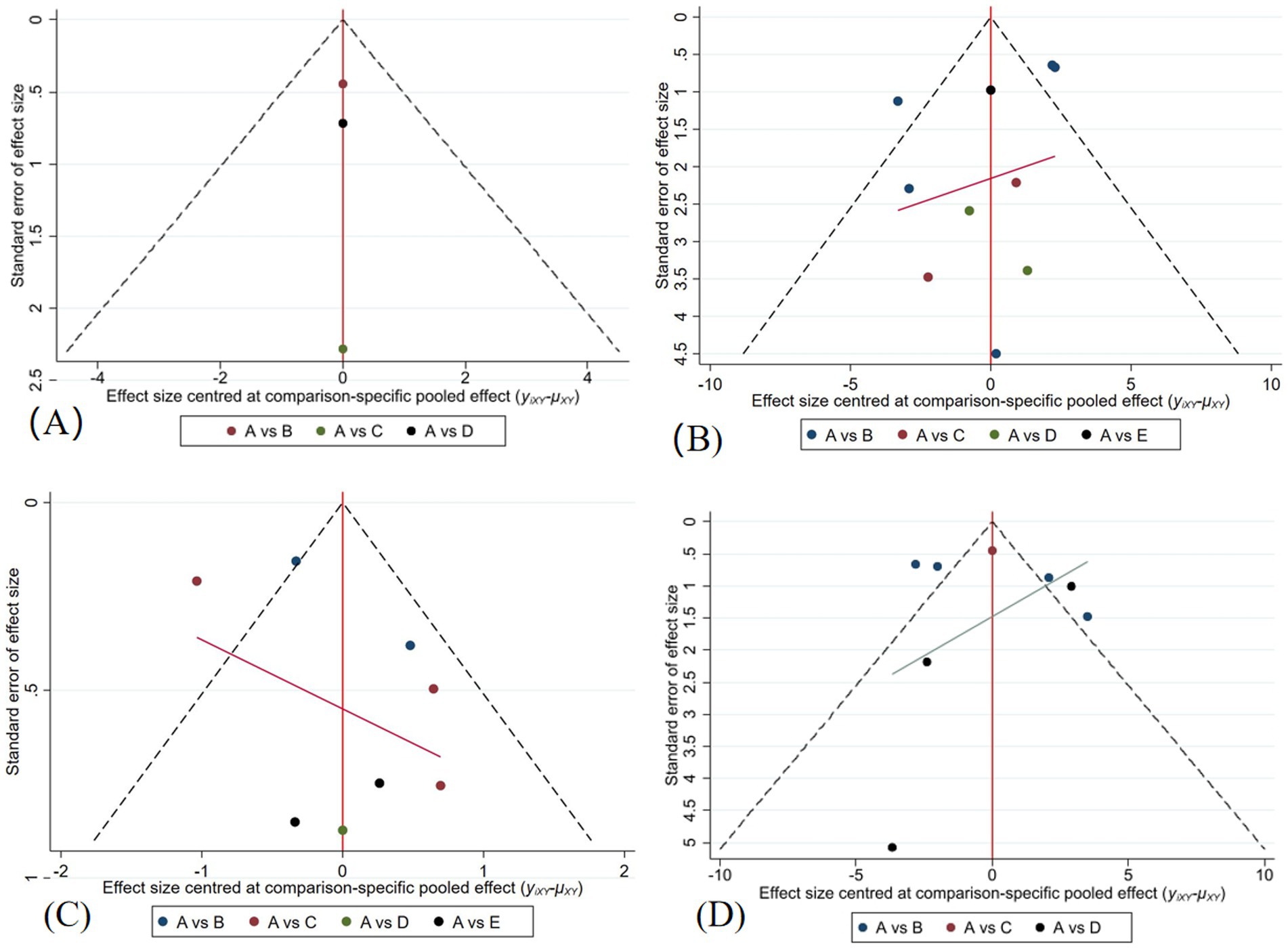
Figure 15. (A) A Funnel Plot for BBS Scores in a Healthy Older Adults; (B) A Funnel Plot for BBS Scores in the Patients with Parkinson’s Disease; (C) A Funnel Plot for TUG Times in a Healthy Older Adults; (D) A Funnel Plot for TUG Times in the Patients with Parkinson’s Disease.
Discussion
Approximately 30 to 40% of community-dwelling older adults aged 65 and above experience falls annually, with women facing a higher risk than men (58). Fall prevention is paramount in mitigating the decline of functional capacity in this population (59). Exercise interventions, including dancing, have been shown to enhance balance abilities, strengthen muscles, improve lower limb flexibility, diminish fall risks, and alleviate fall-related anxiety (60). Dancing, as a joyful and engaging physical activity (61), may offer more sustained benefits than traditional balance and strength training.
Meta-analytic evidence underscores the positive impact of dance interventions on static balance (assessed by BBS scores and SLS time), dynamic balance, and mobility (measured by TUG time) (17), all of which are crucial factors influencing fall risk in older adults (62). For older individuals with chronic conditions, especially with Parkinson’s disease, dance practice not only improves balance but also alleviates symptoms and enhances quality of life (63).
However, there is a dearth of consensus on the “optimal” dance intervention for minimizing fall risks in older adults. The studies included in this paper primarily assessed fall risk through TUG time, Tinetti score, BBS score and SLS time (49). By conducting both direct and indirect comparisons, we aimed to evaluate the efficacy of various dance interventions in reducing fall risks among older adults, thereby facilitating the selection of the most effective dance intervention.
Age-related alterations in the sensorimotor and neuromuscular systems adversely impact the performance of both static and dynamic postural control among older adults (64). To assess these changes, BBS is employed, which evaluates both dynamic and static balance through a comprehensive set of 14 mobility-related tasks categorized into three domains: sitting balance, standing balance, and dynamic balance (65). Berg Balance Score (BBS) was significantly improved in the creative dance group compared to the control group (p < 0.05). Additionally, Creative dance was the most effective intervention. Research indicates that training to respond to the rhythms of improvisational music can lead to the development of highly automated gait patterns, resulting in enhanced gait performance and improved balance and mobility (66). Creative dance, which requires participants to adapt improvisationally to changes in music such as rhythm, tempo, and melody, fosters continuous reactions to external stimuli within a dynamic spatio-temporal environment (67). This type of dynamic training (68) has been shown to be beneficial for improving physical factors associated with falls, including strength, dynamic balance, and mobility, thereby contributing to fall prevention (42).
The Timed Up and Go (TUG) time offers an observational assessment of gait patterns and indirectly quantifies critical fall risk factors, including muscle strength, balance, and gait stability among individuals (28). The network meta-analysis conducted on the Timed Up and Go (TUG) time revealed that among healthy older adult, interventions involving Folk dance, Creative dance, and Ballroom dance were all significantly more effective than the control group in improving performance. Notably, Folk dance emerged as the most efficacious intervention among the three dance styles evaluated.
Slow-paced dance and various support base patterns are pivotal factors in enhancing posture and balance adjustments. Folk dance training, which involves rhythmic motor coordination and control of movements or postures, contributes to the improvement of three bodily systems: the central nervous system, sensory nervous system, and muscular system (69). This type of training benefits the core muscles associated with balance capabilities (70). Muscle strength is a fundamental component for maintaining body balance during movement. Slow-motion exercises can effectively stimulate the functionality of core muscles. Traditional Srichiangmai dance represents an alternative form of aerobic exercise characterized by its slow tempo and low impact. By adhering to the musical rhythm, it engages muscles in various body parts to sustain dance poses, thereby aiding in the enhancement of muscle strength and the improvement of balance (71). Greek traditional dance often requires prolonged single-leg standing, a posture that strengthens the role of the ankle joint in static postural control, effectively reducing postural sway in older adults and significantly increasing single-leg standing time (72). Additionally, the diverse activities involved in traditional Greek dance, including head and body rotations, weight shifts, and transitions from double-leg to single-leg stances, continually challenge the postural control system. These movements have been shown to improve specific aspects of dynamic balance control (73). Thai classical dance is characterized by its slow, continuous dance and musical rhythms. The combination of its movements and rhythms is comparable to Tai Chi, and it also features intricate postures and coordination patterns. Thai classical dance training programs consist of various modes of stretching and repetitive movements, involving the head, upper body, and the entire body’s center of gravity on various support bases. Despite differing stimulation modes of sensory information, these activities necessitate adjustments to the postural system to maintain control over posture and body orientation, potentially influencing the dancer’s balance performance (74). Furthermore, folk dances are often associated with specific cultural backgrounds. Older adults participating in such dances may experience increased engagement and enjoyment due to cultural identity and social interaction, leading to additional physical and psychological benefits. Additionally, the popularity of folk dances among communities and older populations may provide greater access and opportunities for older adults to engage in these dances, thereby benefiting from their fall risk reduction effects.
The Network meta-analysis conducted using the Berg Balance Scale (BBS) revealed that, among patients with Parkinson’s disease, interventions involving Folk dance and Ballroom dance were both significantly more effective than the control group in improving performance. Additionally, Folk dance exhibited a superior intervention effect compared to Social dance.
The optimal exercise intervention for individuals with Parkinson’s disease (PD) should integrate cueing strategies, balance training, focused attention, and enhancement of physical fitness (75). Traditional folk dances have the capacity to stimulate specific deep limbic neuronal circuits, eliciting emotional engagement while incorporating movement elements within the rhythmic structure of the dance, which can be understood as a therapeutic modality (76). For instance, Irish Set Dancing has gained popularity among PD patients due to its relative simplicity and ease of learning and execution (39). This dance form combines dynamic balance activities with gait and skilled movements (39), leading to improvements in PD motor symptoms such as balance impairments, freezing of gait, and bradykinesia (75, 77, 78). Furthermore, Irish dance incorporates elements of exercise, socialization, and partner involvement, motivating PD patients to adhere to long-term physical activity (39). This integrated approach to Folk dance not only addresses the motor symptoms of PD but also fosters emotional well-being and social engagement, which are crucial components of patient care.
In older adult with Parkinson’s disease (PD), specific risk factors render them more susceptible to falls and fall-related injuries. Tango is a kind of social dance with the potential to mitigate balance impairments in this patient population, thereby aligning with previous meta-analytic findings that highlight its benefits (75, 79, 80). Argentine Tango, in particular, may enhance motor capabilities by targeting PD-related impairments such as spontaneous changes in movement direction/speed and frequent transitions between movement initiation and cessation. These features could specifically address difficulties in movement initiation, turning, and bradykinesia. For instance, patients with PD often exhibit slowed movements, but with the aid of external cues, they can achieve near-normal speed and amplitude of movements (77, 81). Such external cues may access cortical circuits, bypassing the dysfunctional basal ganglia in PD patients (82). Ballroom dance, particularly its social aspect, offers crucial external cues: music and a dance partner. Music serves as an auditory cue, enhancing gait speed, initiation speed, and step frequency when utilized. A partner, through physical contact, can further augment balance, as even mild touch can facilitate postural stability (83). The connection between partners may aid in movement initiation and increase or maintain step length and rhythm (84). While physical and psychological benefits accrue to PD patients engaging in exercise training, the severity of the disease influences motor responsiveness; thus, this should be considered when selecting intervention modalities. Only in patients with milder symptoms and slower disease progression (85) does exercise appear to reduce fall incidents.
Study Limitations: (1) The limited number of studies and modest sample sizes incorporated in this analysis may introduce bias into the study outcomes. To mitigate this, we recommend conducting a large-scale, multi-arm randomized controlled trial (RCT) specifically focused on dance interventions, thereby enabling a more robust evaluation of the effectiveness of individual dance types in preventing falls among older adults. (2) The heterogeneity in the fall indicators assessed across the included studies precludes the analysis of more generalized metrics. To address this, we suggest adopting standardized testing methodologies that comprehensively assess fall risk in older adults, thereby facilitating cross-study comparisons and enhancing the reliability of findings. (3) The research focused solely on the analysis of healthy older adult and patients with Parkinson’s disease, and did not comprehensively examine other chronic disease patient groups. Consequently, we propose that future dance interventions targeting patients with chronic diseases should be implemented, with careful consideration given to the potential moderating effects of age, gender, and disease severity on motor function outcomes.
Conclusion
Creative dance, Folk dance, and Ballroom dance effectively reduce the risk of falls in older adults. Creative dance enhanced the Berg Balance Score the most among healthy older adults, while Folk dance improved the Timed Up and Go test performance the best. Similarly, among patients with Parkinson’s disease, Folk dance exhibits the best effect in improving Berg Balance Scale scores. Future research should incorporate more high-quality randomized controlled trials (RCTs) to elucidate the effectiveness of different dance styles in mitigating falls among older adult with varying health statuses, thereby addressing the unique needs of diverse older adult for fall prevention.
Data availability statement
The original contributions presented in the study are included in the article/supplementary material, further inquiries can be directed to the corresponding author.
Author contributions
YL: Data curation, Conceptualization, Methodology, Writing – original draft. ZW: Data curation, Methodology, Software, Supervision, Validation, Writing – original draft. JL: Data curation, Conceptualization, Supervision, Writing – review & editing. HY: Data curation, Methodology, Writing – original draft. ZF: Conceptualization, Formal Analysis, Methodology, Software, Supervision, Writing – review & editing.
Funding
The author(s) declare that financial support was received for the research, authorship, and/or publication of this article. This research was funded by the National Key Research and Development Program of China (2020YFC2002902).
Conflict of interest
The authors declare that the research was conducted in the absence of any commercial or financial relationships that could be construed as a potential conflict of interest.
Publisher’s note
All claims expressed in this article are solely those of the authors and do not necessarily represent those of their affiliated organizations, or those of the publisher, the editors and the reviewers. Any product that may be evaluated in this article, or claim that may be made by its manufacturer, is not guaranteed or endorsed by the publisher.
References
1. Chen, BK, Jalal, H, Hashimoto, H, Suen, SC, Eggleston, K, Hurley, M, et al. Forecasting trends in disability in a super-aging society: adapting the future elderly model to Japan. J Econ Ageing. (2016) 8:42–51. doi: 10.1016/j.jeoa.2016.06.001
2. Cheng, P, Tan, L, Ning, P, Li, L, Gao, Y, Wu, Y, et al. Comparative effectiveness of published interventions for elderly fall prevention: a systematic review and network meta-analysis. Int J Environ Res Public Health. (2018) 15:498. doi: 10.3390/ijerph15030498
3. Stel, VS, Smit, JH, Pluijm, SM, and Lips, P. Consequences of falling in older men and women and risk factors for health service use and functional decline. Age Ageing. (2004) 33:58–65. doi: 10.1093/ageing/afh028
4. Tinetti, ME, and Kumar, C. The patient who falls: "It's always a trade-off". JAMA. (2010) 303:258–66. doi: 10.1001/jama.2009.2024
5. World Health Organization. WHO global report on falls prevention in older age. Geneva: World Health Organization (2007).
6. Deandrea, S, Lucenteforte, E, Bravi, F, Foschi, R, La Vecchia, C, and Negri, E. Risk factors for falls in community-dwelling older people: a systematic review and meta-analysis. Epidemiology. (2010) 21:658–68. doi: 10.1097/EDE.0b013e3181e89905
7. Ruan, AC, and Zheng, P. Study on fall risk factors among the elderly in Suzhou. J Nurs Admin. (2017) 17:186–8. doi: 10.3969/j.issn.1671-315X.2017.03.012
8. Li, JM, He, MY, and Ye, CY. Progress in fall intervention for community elderly. Chin J Gerontol. (2021) 41:5158–64. doi: 10.3969/j.issn.1005-9202.2021.22.081
9. Liu, YB, and Li, JN. Fall and balance and abnormal abnormalities in the elderly. Chin J Rehabil Theory Pract. (2012) 18:5–8. doi: 10.3969/j.issn.1006-9771.2012.01.003
10. Wang, JX, Yao, R, Long, YJ, and Zhang, QL. Current status and hotspot analysis of the relationship between gait and balance characteristics and falls in the elderly. Chin Nurs Res. (2020) 34:2264–70. doi: 10.12102/j.issn.1009-6493.2020.13.004
11. Franco, MR, Sherrington, C, Tiedemann, A, Pereira, LS, Perracini, MR, Faria, CSG, et al. Effect of senior dance (DanSE) on fall risk factors in older adults: a randomized controlled trial. Phys Ther. (2020) 100:600–8. doi: 10.1093/ptj/pzz187
12. Lima, MMS, and Vieira, AP. Ballroom dance as therapy for the elderly in Brazil. Am J Dance Ther. (2007) 29:129–42. doi: 10.1007/s10465-007-9040-9
13. Wallmann, HW, Gillis, CB, Alpert, PT, and Miller, SK. The effect of a senior jazz dance class on static balance in healthy women over 50 years of age: a pilot study. Biol Res Nurs. (2009) 10:257–66. doi: 10.1177/1099800408322600
14. Alpert, PT, Miller, SK, Wallmann, H, Havey, R, Cross, C, Chevalia, T, et al. The effect of modified jazz dance on balance, cognition, and mood in older adults. J Am Acad Nurse Pract. (2009) 21:108–15. doi: 10.1111/j.1745-7599.2008.00392.x
15. Jeon, MY, Bark, ES, Lee, EG, Im, JS, Jeong, BS, and Choe, ES. The effects of a Korean traditional dance movement program in elderly women. Taehan Kanho Hakhoe Chi. (2005) 35:1268–76. doi: 10.4040/jkan.2005.35.7.1268
16. Verghese, J. Cognitive and mobility profile of older social dancers. J Am Geriatr Soc. (2006) 54:1241–4. doi: 10.1111/j.1532-5415.2006.00808.x
17. Blanco-Rambo, E, Bandeira-Guimarães, M, Vieira, AF, Pietta-Dias, C, Izquierdo, M, and Cadore, EL. Dance as an intervention to reduce fall risk in older adults: a systematic review with a meta-analysis. J Aging Phys Act. (2022) 30:1118–32. doi: 10.1123/japa.2021-0404
18. Hackney, ME, Hall, CD, Echt, KV, and Wolf, SL. Dancing for balance: feasibility and efficacy in oldest-old adults with visual impairment. Nurs Res. (2013) 62:138–43. doi: 10.1097/NNR.0b013e318283f68e
19. Abreu, M, and Hartley, G. The effects of salsa dance on balance, gait, and fall risk in a sedentary patient with Alzheimer's dementia, multiple comorbidities, and recurrent falls. J Geriatr Phys Ther. (2013) 36:100–8. doi: 10.1519/JPT.0b013e318267aa54
20. Patterson, KK, Wong, JS, Nguyen, TU, and Brooks, D. A dance program to improve gait and balance in individuals with chronic stroke: a feasibility study. Top Stroke Rehabil. (2018) 25:1–7. doi: 10.1080/10749357.2018.1469714
21. Sharp, K, and Hewitt, J. Dance as an intervention for people with Parkinson's disease: a systematic review and meta-analysis. Neurosci Biobehav Rev. (2014) 47:445–56. doi: 10.1016/j.neubiorev.2014.09.009
22. Zhao, Y, Yin, M, Yao, X, and Li, Z. Effects of nurse-led square dancing on older patients with mild cognitive impairment combined with depressive symptoms: a pilot study. Geriatr Nurs. (2021) 42:1164–71. doi: 10.1016/j.gerinurse.2021.06.028
23. Fernández-Argüelles, EL, Rodríguez-Mansilla, J, Antunez, LE, Garrido-Ardila, EM, and Muñoz, RP. Effects of dancing on the risk of falling related factors of healthy older adults: a systematic review. Arch Gerontol Geriatr. (2015) 60:1–8. doi: 10.1016/j.archger.2014.10.003
24. Tian, JH, and Li, L. Network Meta-analysis methods and practices. Beijing: China Medical Science Press (2017).
25. Moher, D, Liberati, A, Tetzlaff, J, and Altman, DGand the PRISMA Group. Reprint--preferred reporting items for systematic reviews and meta-analyses: the PRISMA statement. Phys Ther. (2009) 89:873–80. doi: 10.1093/ptj/89.9.873
26. Liberati, A, Altman, DG, Tetzlaff, J, Mulrow, C, Gøtzsche, PC, Ioannidis, JP, et al. The PRISMA statement for reporting systematic reviews and meta-analyses of studies that evaluate health care interventions: explanation and elaboration. J Clin Epidemiol. (2009) 62:e1–e34. doi: 10.1016/j.jclinepi.2009.06.006
28. Browne, W, and Nair, BKR. The timed up and go test. Med J Aust. (2019) 210:13–4. doi: 10.5694/mja2.12045
29. Köpke, S, and Meyer, G. The Tinetti test: babylon in geriatric assessment. Z Gerontol Geriatr. (2006) 39:288–91. doi: 10.1007/s00391-006-0398-y
30. Yuan, JF, Zhang, QX, and Lu, A. Application of one-legged standing method in constitution testing. Chin J Tissue Eng Res. (2013) 33:6049–54. doi: 10.3969/j.issn.2095-4344.2013.33.023
31. Salanti, G, Ades, AE, and Ioannidis, JP. Graphical methods and numerical summaries for presenting results from multiple-treatment meta-analysis: an overview and tutorial. J Clin Epidemiol. (2011) 64:163–71. doi: 10.1016/j.jclinepi.2010.03.016
32. Shigematsu, R, Chang, M, Yabushita, N, Sakai, T, Nakagaichi, M, Nho, H, et al. Dance-based aerobic exercise may improve indices of falling risk in older women. Age Ageing. (2002) 31:261–6. doi: 10.1093/ageing/31.4.261
33. Federici, A, Bellagamba, S, and Rocchi, MB. Does dance-based training improve balance in adult and young old subjects? A pilot randomized controlled trial. Aging Clin Exp Res. (2005) 17:385–9. doi: 10.1007/BF03324627
34. Eyigor, S, Karapolat, H, Durmaz, B, Ibisoglu, U, and Cakir, S. A randomized controlled trial of Turkish folklore dance on the physical performance, balance, depression and quality of life in older women. Arch Gerontol Geriatr. (2009) 48:84–8. doi: 10.1016/j.archger.2007.10.008
35. Hackney, ME, and Earhart, GM. Short duration, intensive tango dancing for Parkinson disease: an uncontrolled pilot study. Complement Ther Med. (2009) 17:203–7. doi: 10.1016/j.ctim.2008.10.005
36. Holmerová, I, Machácová, K, Vanková, H, Veleta, P, Jurasková, B, Hrnciariková, D, et al. Effect of the exercise dance for seniors (EXDASE) program on lower-body functioning among institutionalized older adults. J Aging Health. (2010) 22:106–19. doi: 10.1177/0898264309351738
37. Keogh, JWL, Kilding, A, Pidgeon, P, Ashley, L, and Gillis, D. Effects of different weekly frequencies of dance on older adults’ functional performance and physical activity patterns. Europ J Sports Exerc Sci. (2012) 37:14–23.
38. McKee, KE, and Hackney, ME. The effects of adapted tango on spatial cognition and disease severity in Parkinson's disease. J Mot Behav. (2013) 45:519–29. doi: 10.1080/00222895.2013.834288
39. Volpe, D, Signorini, M, Marchetto, A, Lynch, T, and Morris, ME. A comparison of Irish set dancing and exercises for people with Parkinson's disease: a phase II feasibility study. BMC Geriatr. (2013) 13:54. doi: 10.1186/1471-2318-13-54
40. Kaltsatou, AC, Kouidi, EI, Anifanti, MA, Douka, SI, and Deligiannis, AP. Functional and psychosocial effects of either a traditional dancing or a formal exercising training program in patients with chronic heart failure: a comparative randomized controlled study. Clin Rehabil. (2014) 28:128–38. doi: 10.1177/0269215513492988
41. Cepeda, CC, Lodovico, A, Fowler, N, and Rodacki, AL. Effect of an eight-week ballroom dancing program on muscle architecture in older adults females. J Aging Phys Act. (2015) 23:607–12. doi: 10.1123/japa.2014-0101
42. Cruz-Ferreira, A, Marmeleira, J, Formigo, A, Gomes, D, and Fernandes, J. Creative dance improves physical fitness and life satisfaction in older women. Res Aging. (2015) 37:837–55. doi: 10.1177/0164027514568103
43. Hashimoto, H, Takabatake, S, Miyaguchi, H, Nakanishi, H, and Naitou, Y. Effects of dance on motor functions, cognitive functions, and mental symptoms of Parkinson's disease: a quasi-randomized pilot trial. Complement Ther Med. (2015) 23:210–9. doi: 10.1016/j.ctim.2015.01.010
44. Machacova, K, Vankova, H, Volicer, L, Veleta, P, and Holmerova, I. Dance as prevention of late life functional decline among nursing home residents. J Appl Gerontol. (2017) 36:1453–70. doi: 10.1177/0733464815602111
45. Rios Romenets, S, Anang, J, Fereshtehnejad, SM, Pelletier, A, and Postuma, R. Tango for treatment of motor and non-motor manifestations in Parkinson's disease: a randomized control study. Complement Ther Med. (2015) 23:175–84. doi: 10.1016/j.ctim.2015.01.015
46. Serrano-Guzmán, M, Aguilar-Ferrándiz, ME, Valenza, CM, Ocaña-Peinado, FM, Valenza-Demet, G, and Villaverde-Gutiérrez, C. Effectiveness of a flamenco and sevillanas program to enhance mobility, balance, physical activity, blood pressure, body mass, and quality of life in postmenopausal women living in the community in Spain: a randomized clinical trial. Menopause. (2016) 23:965–73. doi: 10.1097/GME.0000000000000652
47. Ventura, MI, Barnes, DE, Ross, JM, Lanni, KE, Sigvardt, KA, and Disbrow, EA. A pilot study to evaluate multi-dimensional effects of dance for people with Parkinson's disease. Contemp Clin Trials. (2016) 51:50–5. doi: 10.1016/j.cct.2016.10.001
48. Kunkel, D, Fitton, C, Roberts, L, Pickering, RM, Roberts, HC, Wiles, R, et al. A randomized controlled feasibility trial exploring partnered ballroom dancing for people with Parkinson's disease. Clin Rehabil. (2017) 31:1340–50. doi: 10.1177/0269215517694930
49. Bennett, CG, Angel, N, and Hackney, ME. Mismatch between subjective and objective motor improvements with adapted tango intervention in older adults. Physiother Res Int. (2020) 25:e1835. doi: 10.1002/pri.1835
50. Lee, HJ, Kim, SY, Chae, Y, Kim, MY, Yin, C, Jung, WS, et al. Turo (Qi dance) program for Parkinson's disease patients: randomized, assessor blind, waiting-list control, partial crossover study. Explore (NY). (2018) 14:216–23. doi: 10.1016/j.explore.2017.11.002
51. Leelapattana, P, Unyaphan, S, Kraiwattanapong, C, Woratanarat, P, Kijkunasathain, C, Angsanuntsukh, C, et al. Thai classical dance exercise for fall prevention. J Med Assoc Thail. (2018) 101:S119–26.
52. Michels, K, Dubaz, O, Hornthal, E, and Bega, D. "Dance therapy" as a psychotherapeutic movement intervention in Parkinson's disease. Complement Ther Med. (2018) 40:248–52. doi: 10.1016/j.ctim.2018.07.005
53. Joung, HJ, and Lee, Y. Effect of creative dance on fitness, functional balance, and mobility control in the elderly. Gerontology. (2019) 65:537–46. doi: 10.1159/000499402
54. Qi, M, Zhu, Y, Zhang, L, Wu, T, and Wang, J. The effect of aerobic dance intervention on brain spontaneous activity in older adults with mild cognitive impairment: a resting-state functional MRI study. Exp Ther Med. (2019) 17:715–22. doi: 10.3892/etm.2018.7006
55. Solla, P, Cugusi, L, Bertoli, M, Cereatti, A, Della Croce, U, Pani, D, et al. Sardinian folk dance for individuals with Parkinson's disease: a randomized controlled pilot trial. J Altern Complement Med. (2019) 25:305–16. doi: 10.1089/acm.2018.0413
56. Kalyani, HH, Sullivan, KA, Moyle, GM, Brauer, SG, Jeffrey, ER, and Kerr, GK. Dance improves symptoms, functional mobility and fine manual dexterity in people with Parkinson disease: a quasi-experimental controlled efficacy study. Eur J Phys Rehabil Med. (2020) 56:563–74. doi: 10.23736/S1973-9087.20.06069-4
57. Rodziewicz-Flis, EA, Kawa, M, Kaczor, JJ, Szaro-Truchan, M, Flis, DJ, Lombardi, G, et al. Changes in selected exerkines concentration post folk-dance training are accompanied by glucose homeostasis and physical performance improvement in older adults. Sci Rep. (2023) 13:8596. doi: 10.1038/s41598-023-35583-w
58. Wang, M, Wu, F, Callisaya, ML, Jones, G, and Winzenberg, TM. Neither leg muscle strength nor balance is associated with the incidence of falls in middle-aged women: a 5-year population-based prospective study. J Gerontol A Biol Sci Med Sci. (2021) 76:e187–93. doi: 10.1093/gerona/glab122
59. World Health Organization. Integrated care for older people: Guidelines on community-level interventions to manage declines in intrinsic capacity. Geneva: World Health Organization (2017).
60. Guo, JX, Chen, L, Yu, QC, and Wu, Y. Network Meta-analysis of the effect of exercise on preventing prevention in the elderly. Chin J Rehabil Theory Pract. (2021) 27:563–73. doi: 10.3969/j.issn.1006-9771.2021.05.009
61. Nadasen, K. "Life without line dancing and the other activities would be too dreadful to imagine": an increase in social activity for older women. J Women Aging. (2008) 20:329–42. doi: 10.1080/08952840801985060
62. Casas-Herrero, Á, Sáez de Asteasu, ML, Antón-Rodrigo, I, Sánchez-Sánchez, JL, Montero-Odasso, M, Marín-Epelde, I, et al. Effects of Vivifrail multicomponent intervention on functional capacity: a multicentre, randomized controlled trial. J Cachexia Sarcopenia Muscle. (2022) 13:884–93. doi: 10.1002/jcsm.12925
63. Berti, A, Pini, M, and Ferrarello, F. Argentine tango in the care of Parkinson's disease: a systematic review and analysis of the intervention. Complement Ther Med. (2020) 52:102474. doi: 10.1016/j.ctim.2020.102474
64. Maki, BE, and McIlroy, WE. Postural control in the older adult. Clin Geriatr Med. (1996) 12:635–58. doi: 10.1016/S0749-0690(18)30193-9
65. Miranda, N, and Tiu, TK. Berg balance testing. Treasure Island (FL): StatPearls Publishing (2024).
66. Dhami, P, Moreno, S, and DeSouza, JF. New frame work for rehabilitation - fusion of cognitive and physical rehabilitation: the hope for dancing. Front Psychol. (2015) 5:1478. doi: 10.3389/fpsyg.2014.01478
67. Kressig, RW, Allali, G, and Beauchet, O. Long-term practice of Jaques-Dalcroze eurhythmics pre vents age-related increase of gait variability under a dual task. J Am Geriatr Soc. (2005) 53:728–9. doi: 10.1111/j.1532-5415.2005.53228_2.x
68. Granacher, U, Muehlbauer, T, Zahner, L, Goll Hofer, A, and Kressig, RW. Comparison of tradi tional and recent approaches in the promo tion of balance and strength in older adults. Sports Med. (2011) 41:377–400. doi: 10.2165/11539920-000000000-00000
69. Noopud, P, Suputtitada, A, Khongprasert, S, and Kanungsukkasem, V. Effects of Thai traditional dance on balance performance in daily life among older women. Aging Clin Exp Res. (2019) 31:961–7. doi: 10.1007/s40520-018-1040-8
70. De Lucia, R, and Martin-Dominguez, E. Biomechanics of Caribbean dance: a preliminary study. Dance Ther Sport Med. (1997) 17:7–17.
71. Buransri, M, and Phanpheng, Y. Effects of traditional Srichiangmai dance on balance and mobility in the elderly. Muscles Ligam Tend J. (2021) 11:2. doi: 10.32098/mltj.02.2021.02
72. Amiridis, IG, Hatzitaki, V, and Arabatzi, F. Age-induced modifications of static postural control in humans. Neurosci Lett. (2003) 350:137–40. doi: 10.1016/S0304-3940(03)00878-4
73. Sofianidis, G, Hatzitaki, V, Douka, S, and Grouios, G. Effect of a 10-week traditional dance program on static and dynamic balance control in elderly adults. J Aging Phys Act. (2009) 17:167–80. doi: 10.1123/japa.17.2.167
74. Krityakiarana, W, and Jongkamonwiwat, N. Comparison of balance performance between Thai classical dancers and non-dancers. J Dance Med Sci. (2016) 20:72–8. doi: 10.12678/1089-313X.20.2.72
75. Shanahan, J, Morris, ME, Bhriain, ON, Saunders, J, and Clifford, AM. Dance for people with Parkinson disease: what is the evidence telling us? Arch Phys Med Rehabil. (2015) 96:141–53. doi: 10.1016/j.apmr.2014.08.017
76. Sironi, VA, and Riva, MA. Neurological implications and neuropsychological considerations on folk music and dance. Prog Brain Res. (2015) 217:187–205. doi: 10.1016/bs.pbr.2014.11.027
77. Mori, F, Okada, KI, Nomura, T, and Kobayashi, Y. The Pedunculopontine tegmental nucleus as a motor and cognitive Interface between the cerebellum and basal ganglia. Front Neuroanat. (2016) 10:109. doi: 10.3389/fnana.2016.00109
78. Foley, CE. The irish Céilí: a site for constructing, experiencing, and negotiating a sense of community and identity. Dance Res. (2011) 29:43–60. doi: 10.3366/drs.2011.0004
79. Lötzke, D, Ostermann, T, and Büssing, A. Argentine tango in Parkinson disease--a systematic review and meta-analysis. BMC Neurol. (2015) 15:226. doi: 10.1186/s12883-015-0484-0
80. Tang, L, Fang, Y, and Yin, J. The effects of exercise interventions on Parkinson's disease: a Bayesian network meta-analysis. J Clin Neurosci. (2019) 70:47–54. doi: 10.1016/j.jocn.2019.08.092
81. Baker, K, Rochester, L, and Nieuwboer, A. The immediate effect of attentional, auditory, and a combined cue strategy on gait dur ing single and dual tasks in Parkinson’s disease. Arch Phys Med Rehabil. (2007) 88:1593–600. doi: 10.1016/j.apmr.2007.07.026
82. Freedland, RL, Festa, C, Sealy, M, McBean, A, Elghazaly, P, Capan, A, et al. The effects of pulsed auditory stimulation on various gait measurements in persons with Parkinson’s disease. NeuroRehabilitation. (2002) 12:81–7. doi: 10.3233/NRE-2002-17110
83. Jeka, JJ. Light touch contact as a balance aid. Phys Ther. (1997) 77:476–87. doi: 10.1093/ptj/77.5.476
84. Iansek, R, Huxham, F, and McGinley, J. The sequence effect and gait festination in Parkinson disease: contributors to freezing of gait? Mov Disord. (2006) 21:1419–24. doi: 10.1002/mds.20998
Keywords: dance, older adults, falls, balance, network meta-analysis
Citation: Li Y, Wang Z, Li J, Yang H and Fang Z (2024) The effects of dance interventions on reducing the risk of falls in older adults: a network meta-analysis. Front. Public Health. 12:1496692. doi: 10.3389/fpubh.2024.1496692
Edited by:
Marcia G. Ory, Texas A&M University, United StatesReviewed by:
Tiffany E. Shubert, University of North Carolina at Chapel Hill, United StatesRogerio Hirata, Aalborg University, Denmark
Copyright © 2024 Li, Wang, Li, Yang and Fang. This is an open-access article distributed under the terms of the Creative Commons Attribution License (CC BY). The use, distribution or reproduction in other forums is permitted, provided the original author(s) and the copyright owner(s) are credited and that the original publication in this journal is cited, in accordance with accepted academic practice. No use, distribution or reproduction is permitted which does not comply with these terms.
*Correspondence: Zilong Fang, ZmFuZ3ppbG9uZ0Bic3UuZWR1LmNu
 Ying Li
Ying Li Zhaoguo Wang
Zhaoguo Wang Jiahao Li
Jiahao Li Honghao Yang2
Honghao Yang2 Zilong Fang
Zilong Fang